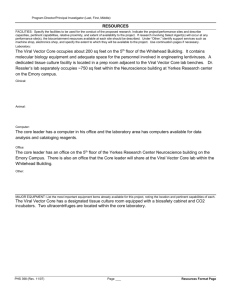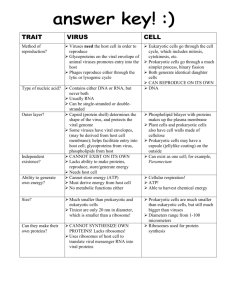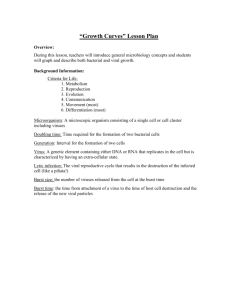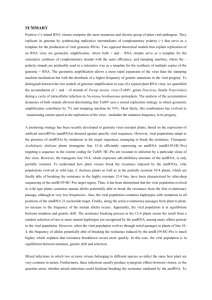Bi 11 PBL: Design a Viral Vector
advertisement
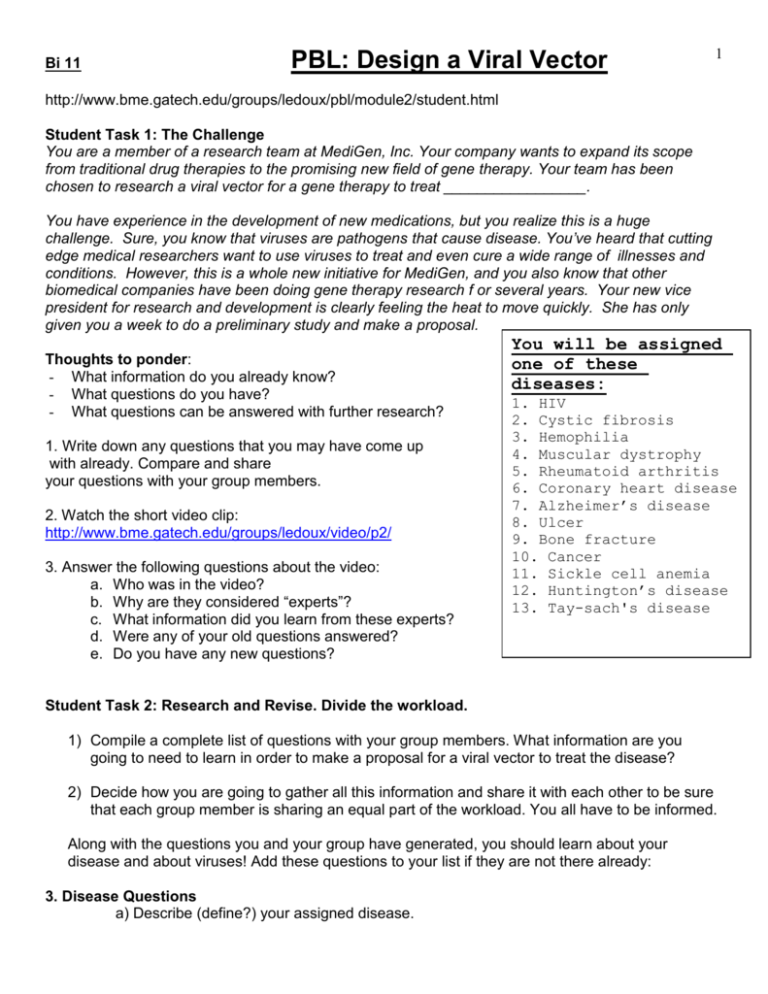
Bi 11 PBL: Design a Viral Vector 1 http://www.bme.gatech.edu/groups/ledoux/pbl/module2/student.html Student Task 1: The Challenge You are a member of a research team at MediGen, Inc. Your company wants to expand its scope from traditional drug therapies to the promising new field of gene therapy. Your team has been chosen to research a viral vector for a gene therapy to treat _________________. You have experience in the development of new medications, but you realize this is a huge challenge. Sure, you know that viruses are pathogens that cause disease. You’ve heard that cutting edge medical researchers want to use viruses to treat and even cure a wide range of illnesses and conditions. However, this is a whole new initiative for MediGen, and you also know that other biomedical companies have been doing gene therapy research f or several years. Your new vice president for research and development is clearly feeling the heat to move quickly. She has only given you a week to do a preliminary study and make a proposal. Thoughts to ponder: - What information do you already know? - What questions do you have? - What questions can be answered with further research? 1. Write down any questions that you may have come up with already. Compare and share your questions with your group members. 2. Watch the short video clip: http://www.bme.gatech.edu/groups/ledoux/video/p2/ 3. Answer the following questions about the video: a. Who was in the video? b. Why are they considered “experts”? c. What information did you learn from these experts? d. Were any of your old questions answered? e. Do you have any new questions? You will be assigned one of these diseases: 1. HIV 2. Cystic fibrosis 3. Hemophilia 4. Muscular dystrophy 5. Rheumatoid arthritis 6. Coronary heart disease 7. Alzheimer’s disease 8. Ulcer 9. Bone fracture 10. Cancer 11. Sickle cell anemia 12. Huntington’s disease 13. Tay-sach's disease Student Task 2: Research and Revise. Divide the workload. 1) Compile a complete list of questions with your group members. What information are you going to need to learn in order to make a proposal for a viral vector to treat the disease? 2) Decide how you are going to gather all this information and share it with each other to be sure that each group member is sharing an equal part of the workload. You all have to be informed. Along with the questions you and your group have generated, you should learn about your disease and about viruses! Add these questions to your list if they are not there already: 3. Disease Questions a) Describe (define?) your assigned disease. PBL: Design a Viral Vector Bi 11 b) What areas of the body does it affect? c) What causes it? d) What are the symptoms and side affects? e) What is the longevity of a person afflicted with this disease? 4. Viral Questions a) What is a virus? b) What components make up a virus? c) What are ways that viruses differ? d) What the goal/job of a virus? e) Are viruses good or are they bad? Can they be both? Give specific examples. f) How do viruses replicate? g) Are viruses living? Why or why? Student Task 4: Viral Toolbox. 1. Go to the following website: http://learn.genetics.utah.edu/units/genetherapy/gttools/ Read about vectors and answer the following questions: a. What is a vector? b. Why are viral vectors useful? c. What are some of drawbacks to viral vectors d. What are some non-viral vectors? 2. At the genetics website above, read about viral reproduction (you need to know this for your test anyway!) Take notes on the two main types. Refer to your textbook for further clarification. 3. At the same website (above), go to the toolbox in the middle of the page. Read and take notes about the different viruses. Split the viruses up so that everyone is reading and taking notes on some of them. Keep in mind what information you think might be important in determining what type of viral vector to use. Here are some websites you might try to get you started on your research: http://www.webmd.com/diseases_and_conditions/default.htm http://www.cdc.gov/travel/diseases.html http://www.pslgroup.com/dg/disrefsites.htm http://www.mayoclinic.com/ http://www.biology.arizona.edu/CELL_BIO/tutorials/pev/page4.html http://biology.about.com/library/weekly/aa110200a.htm http://www.kcom.edu/faculty/chamberlain/Website/Lects/PROPERT.HTM http://www.nslc.wustl.edu/courses/bio100a/templeton/L23.pdf http://www.people.ku.edu/~jbrown/virus.html 2 3 PBL: Design a Viral Vector Bi 11 Student Task 5: Test Your Mettle: Space Doctor Diagnosis Sheet Go to http://learn.genetics.utah.edu/units/genetherapy/spacedoctor/ and test your knowledge of viral vectors and disease characteristics. You will be presented with three different patients. Take notes on their medical history. Prescribe treatment and note success and failures. If needed re-prescribe treatment until you have found something that works. Patient Name Medical Notes Viral Vector Used Location of Vector Delivery Outcome Success or Failure? Why? Additional Notes PBL: Design a Viral Vector Bi 11 4 Student Task 6: Test Your Mettle: Design a Virus Your task is to create a cartoon strip to demonstrate a “Day in the Life of a Virus.” You may make a comic strip of a real virus such as HIV or you may create a virus like the “Shopping Virus.” Your comic strip should contain at least 6 panels, include pictures and text, be in color, and contain the following: a. b. c. d. e. f. g. Viral name Viral parts shown and labeled Mode of transmission Symptoms the virus causes Is the virus “good”? “Bad”? Duration of viral activity How the virus reproduces Student Task 6: Go Public: PowerPoint Presentation As a research team, you will create a PowerPoint slide show to present your findings to the MediGen, Inc board of trustees. Your presentation should include the following: a. Introduction to viral vectors and their use for gene therapy b. Information about your disease c. Suggestions for what viral vector should be tried for your assigned disease and why your group believes this is the best choice
